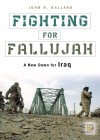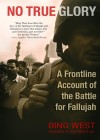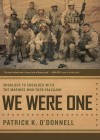Fighting for Fallujah,
Written by: John R. Ballard,
Praeger Security International, Westport, CT, 2006,
ISBN: 9780275990558, 152 pp.
No True Glory: A Frontline Account of the Battle of Fallujah
Written by: Bing West,
Bantam Book, New York, 2006,
ISBN: 9780553383195, 378 pp.
We Were One: Shoulder to Shoulder with the Marines who took Fallujah
Written by: Patrick K. O’Donnell,
Da Capo, Cambridge, MA, 2006,
ISBN: 9780306815737, 244 pp.
For much of 2004 the most consistent problem spot for the American-led coalition in Iraq, after Baghdad, was the city of Fallujah. Due west of Baghdad, on the banks of the Euphrates River in Sunni-dominated Al Anbar Province, Fallujah was a safe haven for a volatile mix of al-Qaeda operatives, foreign jihadists, Saddam loyalists and Islamic fundamentalists, as well as gangs of smugglers, extortionists, kidnappers and murderers. The result was a city in which the rule of law had ceased to operate and its primary industry had become the organisation and export of terrorism and death.
In 2004 Fallujah was to see two major American offensives to eliminate its terrorists and criminal elements and to restore the nascent Iraqi Government’s control over the city. The instigation for the April assault was the murdering, quartering, burning, and finally, hanging of four US contractors who had unwisely attempted to drive through the city. The first offensive was largely a Marine affair that was mounted on short notice and then stopped due to political pressure resulting from prejudicial and highly negative media coverage. The failure of the Bush Administration’s resolve to clear out the city encouraged America’s enemies. Fallujah became an even more important centre for those who opposed the US presence in the country, rejected the authority of the Shiite-dominated central government, sought to make money through criminal acts, or espoused a fundamentalist ideology. In November the Marines returned to Fallujah, with US Army and Iraqi Army support. This time political pressure failed to stop the attack and US troops pressed home their assault, clearing the city. However, ferocious fighting, reminiscent of the Battle of Hue in the Vietnam War, reduced much of the city to rubble.
Although all three authors treat the same subject, each brings a different focus and objective to his book. John R. Ballard’s Fighting for Fallujah: A New Dawn for Iraq, looks at the higher levels of the operation’s planning and conduct, and gives particular emphasis to its civil affairs aspects. Bing West in No True Glory: A Frontline Account of the Battle for Fallujah examines both assaults on the city from the perspective of a ground commander. Patrick K. O’Donnell’s We Were One: Shoulder to Shoulder with the Marines who took Fallujah, tells the grunts’ story through the lens of a rifle company.
Ballard’s book is the shortest of the three, which is unfortunate. In only 116 pages of narrative he covers both attacks on Fallujah as well as the American reconstruction effort. While he makes a correct and compelling case for the integration of civil affairs directly and early into an operation’s planning, there is not enough space to cover his subjects in the needed depth. Moreover, as commander of 4th Civil Affairs Group, the unit tasked with Fallujah’s reconstruction, Ballard is a less capable writer when describing the fighting than when discussing the rebuilding. Consequently, his description of the combat lacks the passion that the other authors bring to their works. Instead of hard-edged battle writing, Ballard’s narrative of combat carries the tone and pacing of an after-action report and his book compares poorly with the other works as a result.
Ballard’s book also suffers from the author’s closeness to his subject. While his direct involvement in the operation provides him with unique insights, he is unable to temper his optimism regarding the outcome of the Fallujah offensive, as well as other missions taking place elsewhere in Iraq. Ballard is correct that the November battle for Fallujah transformed the city from one of Iraq’s most dangerous to one of its safest, but he overlooks the cost that the change required. The ongoing violence in Iraq would also suggest that Ballard’s optimism is misplaced when applied to other operations. For example, his claim that the August 2004 battle for Najaf represented the beginning of the end for the Mahdi Militia and its charismatic leader Muqtada al-Sadr has been seen to be overly ambitious.
No True Glory is West’s second book on the Iraq War, following The March Up: Taking Baghdad With the 1st Marine Division (with Major General Ray L. Smith). As a Marine and Vietnam War veteran, West understands his subject. While much of the book is seen from the perspective of the front-line soldier, West is also comfortable dealing with operational, strategic and political issues. This is a book that works well at all levels of war.
One of West’s more troubling observations concerns the ongoing inability of the US Administration to recognise and consider the importance of strategy. Other recent books, for example Thomas E. Ricks’s excellent Fiasco: The American Military Adventure in Iraq, painfully reiterates the numerous strategic follies committed by the Bush Administration in its design for the Iraq War. In No True Glory, West extrapolates this tendency for routine planning malpractice down into the operational level of war. The United States organised the April attack in haste, reacting emotionally to the murder of the contractors. The Marines were ordered into Fallujah, against the objections of their commanders, with an ill-conceived plan for which there had not been time to define critical concepts such as a mission objective. Nor had steps been taken to warn the civilian population, consult with allies and Congress, or organise the re-establishment of civil government. Moreover, the Bush Administration, having launched the attack on the basis of emotion, ended it suddenly and for similar reasons in the face of the enemy’s highly effective information campaign. When the United States concluded the April battle by handing the city over to the questionable loyalty of the Fallujah Brigade—who soon joined the insurgency—it was symptomatic of an Administration that had not thought through what it hoped to accomplish when it ordered the attack.
O’Donnell’s We Were One has the most singular focus of the three books. It delivers an in-your-face depiction of turbo-charged combat as experienced by the men of Lima Company, 3/1 Marine Battalion, in the November attack on Fallujah. O’Donnell depicts urban warfare on steroids and it is not a book for the faint-hearted, nor is it for readers who prefer the subtlety and complexity provided by the war and society school of historical methodology. Instead, We Were One is description of the use of controlled violence, through the application of overwhelming firepower and superior small-unit tactics, in the pursuit of a military objective in the urban setting. It should be mandatory reading for the Australian Army’s junior leaders and, possibly, project managers involved in weapon design and acquisition.
O’Donnell can write with such strength and veracity because he sought to have himself embedded with the Marines in Fallujah: he was with Lima Company for the operation’s second half. The term ‘embedded’ covers many situations. Most of the reporters with American units assigned to Fallujah quickly made their way to the safety of rearward command posts from which they followed the contest for the city on computer screens. O’Donnell, by contrast, went out on patrols with the troops and dodged enemy fire on Fallujah’s streets, slept rough in half-demolished buildings, experienced the terror and cacophony of battle, and came under such close attack that Marines were wounded and killed around him. He could never be a member of Lima Company—but he was its intimate witness.
The historical community should commend O’Donnell for the realism of his research. However, there are a few points towards the end of We Were One where the objectivity of an author and the perspective of a participant become confused. This is where O’Donnell, in effect, interviews himself, and these brief parts should have been omitted as they take attention from the true centre of the story he tells: the Marines. However, this is a minor quibble and does not detract from what O’Donnell has accomplished.
The three authors all highlight similar tactical lessons in these books. While precision weaponry and enhanced situation awareness are essential force multipliers in modern warfare, it also remains true that if an army puts boots onto the ground in the urban environment, heavy is better than light. The Battles of Fallujah represented urban warfighting at its worst. Such was the intensity of the fighting that the Marines’ effort to root out the insurgents resulted in the damage to or destruction of nearly half of the city’s 39 000 structures. The city’s subjugation also cost the lives of approximately 150 US personnel and at least 1200 insurgents. The Abrams tank was the key weapon system for the attacking Marine and Army soldiers, and they would have appreciated them in greater number. The example of Fallujah should lay to rest any further debate over the wisdom of the Government’s decision to harden the Australian Army.
The utility of artillery in urban warfare is less clear than that of armour, however. In both attacks, the operation’s preliminary bombardment, including close air support, was relatively light compared to what the US forces could have brought to bear. The political need to fire only at clearly identified hostile targets constrained the amount of fire support that was available to the assaulting troops. Artillery and mortars do not presently have the ability to fire indirectly with the required degree of precision in the urban environment without the acceptance of an uncomfortable degree of risk of friendly or civilian casualties. When the Marines called on the guns they performed well, but Fallujah shows that artillery technology must improve if the arm is to play a decisive role on the contemporary urban battlefield.
In the first battle of Fallujah, the insurgents’ decisive weapon was their ability to achieve a strategic effect by shaping their message through the media. The Al Jazeera network and other broadcasters turned the international political environment against the United States and forced the Bush Administration to stand down the attack. Even worse was the failure by the United States either to counter the enemy’s message or to develop one of their own. In the November assault, the US and Iraqi Governments were able to hinder Al Jazeera’s access to the city and they also made sure to get out their own story. The result was that this time the pressure to end the battle prematurely did not achieve critical mass.
These works confirm that in modern conflict the media is more than just a vehicle through which to transmit morale-boosting stories to the home front. Rather, the media is now a weapon platform of decisive importance in its own right. Information operations are a critical feature of asymmetric warfare, and information and psychological warfare personnel must move closer to the forefront of US combat capabilities. This is an area of warfare that the United States, and its allies, must master.
West and O’Donnell also share a discomforting rationale for writing their books. Both authors perceived the need to seize the high ground in honouring the US personnel who fought in Iraq. They acted in reaction to one of the most shameful periods in US history, namely the aftermath of the Vietnam conflict when a war-disillusioned society disowned its returning heroes. West and O’Donnell are determined that a new generation of military men and women will receive the honour they deserve, and they have written these books as homages to America’s front-line warriors. Worryingly, as the United States continues its slide towards a collective failure of will in Iraq, West’s and O’Donnell’s foresight has not yet, but may still, prove a necessity.
Beyond the treatment of its veterans, the destruction of Fallujah also challenges military strategists and planners to once again reconsider the nature of twenty-first century war. In an era where non-conventional warfare is meant to dominate the operational art, where the emphasis in warfighting is supposed to have shifted to asymmetric warfare, and where advanced weaponry and battlespace dominance is thought to have transformed the course of a conflict into a fast, precise and painless exercise, Fallujah stands out as an exception. Despite considerable US effort, ‘Hearts and Minds’ was never a viable strategy with which to cleanse Fallujah.
Yet while Fallujah confirms the ongoing need for armies to be able to wage conventional operations, it would be a mistake to draw the conclusion that the principles of counterinsurgency operations are of lesser importance. No True Glory and We Were One are powerful, brilliantly written and constructed works that deserve to be read, but the most enduring lesson of this battle is to be found in Fighting for Fallujah. Even with his book’s deficiencies, Ballard’s illustration of combat and civil action as integral parts of the same mission objective points the way to the future of war. The message of the Battle of Fallujah is that the United States and its allies must strive for balance. The United States must retain its superiority in the application of violence, but it must also master the gentler art of coercion by enhancing its force’s capability to conduct information and psychological operations and civil action if it is to succeed in the coming conflicts of the twenty-first century.




